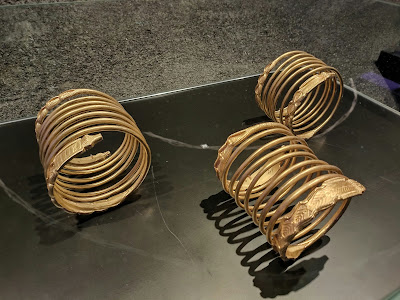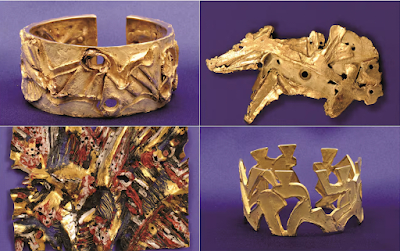The Musée du Hiéron is a gem in Paray-le-Monial, a town known for its medieval architecture and religious history. Located in the heart of Saône-et-Loire, the museum is home to a rich collection that spans various periods of French history. These include archaeological finds, religious artworks, and regional historical objects that trace the area's development from ancient Roman times to the modern era. The museum, designated a national treasure, was created in 1904 by goldsmith-jeweller Joseph Chaumet, who was the who's-who of jewellery makers in Paris at the time. It is especially noted for its focus on two thousand year's of religious history, reflecting Paray-le-Monial’s longstanding connection to Catholicism.
This week however, it was that very religious history which drew the attention of thieves, for the second time...for the second time...but really for the third time.
In the second daylight theft at a French museum in less than one week, yesterday, at approximately 4pm, thieves targeting the Hiéron in a rapid-fire and aggressive theft. Arriving by motorbike, a group of four accomplices, stuck, their target, the museum's religious centrepiece, in what has been described as a well-coordinated and well-timed art heist.
Upon arrival, one of the culprits stood watch outside while three others dashed in, firing several shots overhead to intimidate the museum's employees and visitors. They then made their way over to the museum's national treasure sculpture, the "Via Vitæ" ("The Way of Life").
Purchased by the city for the museum in 2004, the 3 metre by 3 metre majestic artwork is considered to be jeweller Chaumet's masterpiece. It took the goldsmith ten years of work (between 1894 and 1904), to create this epic piece. Steeped in Christian faith, as well as alabaster, gold, precious stones, silver, diamonds, and rock crystal, his sculptural and figural work depicts the most poignant episodes recorded in the life of Christ.


On the front of the mountain are scenes of the Nativity, the Sermon on the Mount, the Wedding at Cana, the Raising of Lazarus and the Last Supper. Higher up on the mountain path, viewers see the Garden of Olives, Christ's flagellation and ultimately, three crosses on the hill of Calvary. The host, symbolising the body of Christ, is brandished by two female figures standing at the top of the mountain, and is set with rubies and diamonds, with the central stone being a large, cut, rock crystal.
On the back side of the mountain, there are various symbols representing Islam, Hinduism, and Buddhism as well as, perhaps subliminally, the seven deadly sins. In total, the sculpture includes 138 figurines, each one delicately accented in gold, as they illustrate all of the important stories and characters of the New Testament, not just the Christmas nativity.
Once inside the museum yesterday, the thieves worked to access the sculpture through its protective glass barrier, placed in front of the artwork to provide security. They then broke through this barrier, purportedly using an angle grinder and a chainsaw. Once the glass was breached, the culprits quickly snatched as many of the small gold and ivory statuettes and jewel encrusted elements as they could and in just two minutes the deed was done and the thieves' escape was made.
Not the first timeThe Musée du Hiéron was already the victim of a burglary on 29 June 2017. At the time, two gold Romay crowns: la couronne de Notre Dame de Romay and the couronne celle de l'Enfant Jésus, created by goldsmith Paul Brunet in 1897, were stolen.
On Sunday, 25 September 2022, a second burglary attempt occurred at around 4am, when three would-be thieves again tried to access the room that houses the "Via Vitæ", by attempting a break-in at the window. Luckily, that time the alarm sounded and the would-be burglars fled empty-handed, in their haste, leaving behind the ladder they had used to access the window.
Impact on the Local Community
The impact of this week's theft on Paray-le-Monial, a town with a population of just over 10,000, has to been profound. For the residents and the staff at the Hiéron Museum, the loss of these objects is more than just a financial blow; it’s a cultural tragedy which sends ripples of concern across the tight-knit community, where the cultural institution serves as a touchstone for local identity and pride.
A Broader Concern for Small Museums
The Hiéron Museum theft is part of a troubling global trend that highlights the vulnerability of small cultural institutions to criminal activity. Museums, galleries, churches, and private collectors have long been targets for thieves seeking to profit from the illicit sale of stolen goods, with plundered religious material being highly prized.
One of the most troubling aspects of the yesterday's theft is the nature of the stolen items. The pieces were not just valuable in a monetary sense but also as sacred and irreplaceable symbols of people's beliefs and traditions. Theft will always be a tragedy for museums, but when it involves beloved artworks that have been part of a community’s fabric, the loss is truly and deeply felt.
 Bernhard Zeeman,dacian,Douglas Chesley Wendersteyt,Drents Museum,Gold,museum theft,romanian,Romanian Police,The Netherlands
Bernhard Zeeman,dacian,Douglas Chesley Wendersteyt,Drents Museum,Gold,museum theft,romanian,Romanian Police,The Netherlands
 No comments
No comments






















































